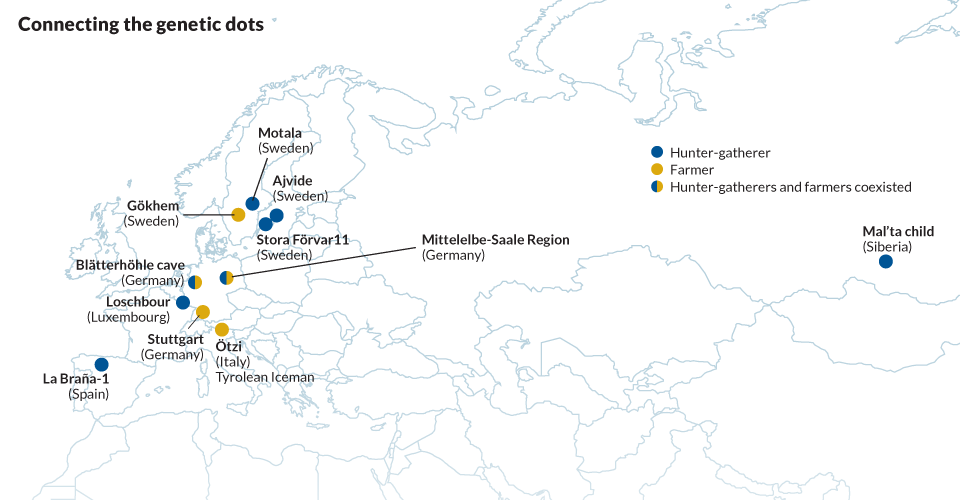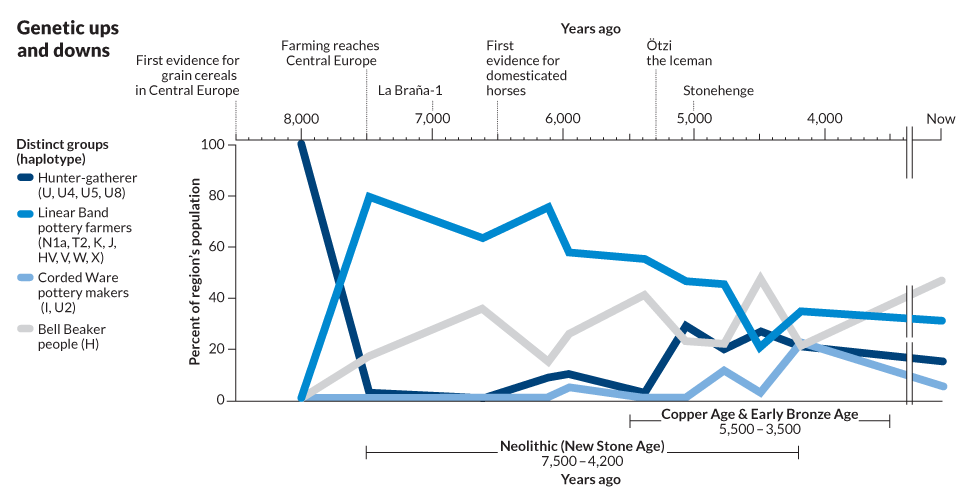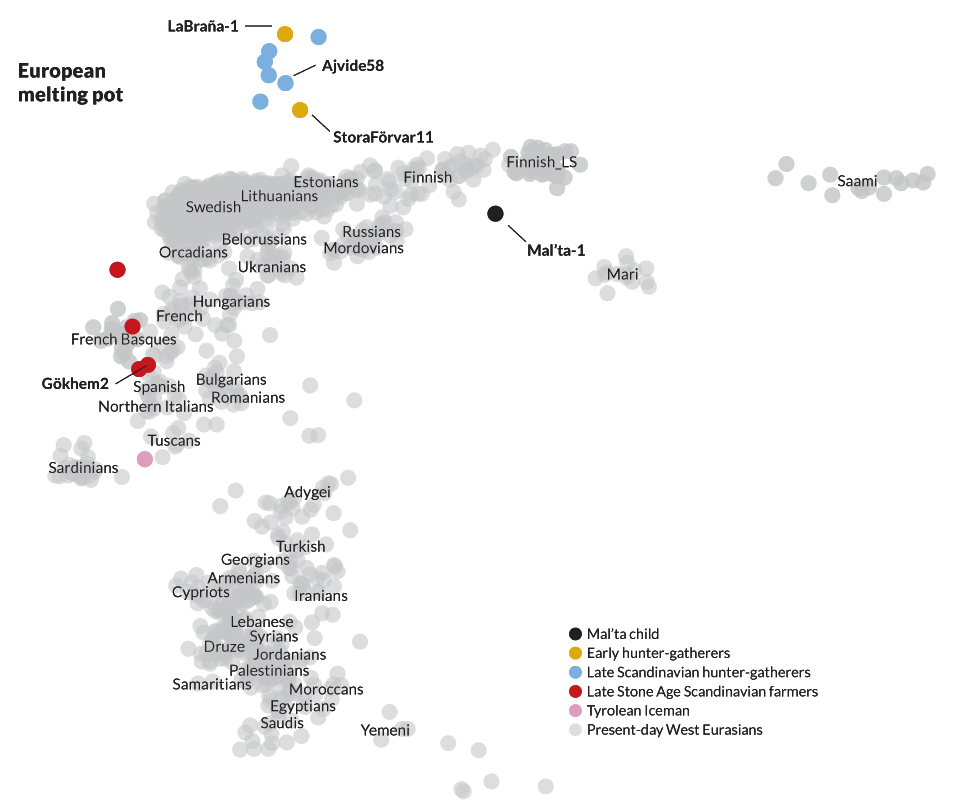Written in bone
Genetic data from ancient Europeans are rewriting the prehistory of the continent
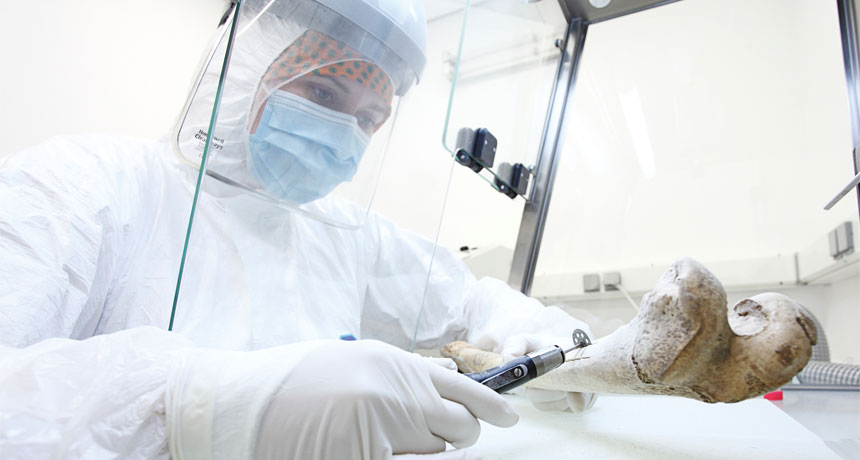
KEEPING CLEAN When studying ancient specimens, researchers work in ultraclean rooms to avoid contaminating samples with DNA from modern people or the environment.
T. Hartmann/Paleogenetics Laboratory, Mainz, Germany
Carles Lalueza-Fox nearly missed an opportunity to paint the genetic portrait of a 7,000-year-old Spaniard.
In 2006, spelunkers stumbled across the ancient remains of two men in a cave in Spain’s Cantabrian mountain range. Lalueza-Fox, an evolutionary geneticist at the Institute of Evolutionary Biology in Barcelona, got a call inviting him to examine the skeletons’ DNA.
“I told them I wasn’t interested,” he recalls. Most of the genetic material in the bones had probably long since crumbled into tiny, unreadable fragments, he assumed. Plus, the technology to piece together nearly disintegrated genetic information wasn’t up to the task. Even if it had been, the skeletons’ DNA had probably become so contaminated with present-day people’s DNA that it would be nearly impossible to tell the old from the new. “There was nothing I could do with it.” He turned down the offer and didn’t think much about it again until 2010, when an international group of researchers announced that it had compiled the genetic instruction book of Neandertals from bones dating back at least 40,000 years (SN: 6/5/10, p. 5), many times older than the Spaniards’ bones.
“I started panicking,” Lalueza-Fox says. He realized he’d passed up a golden opportunity to explore his country’s distant history. He scrambled to find the skeletons, tracing them to a museum basement.
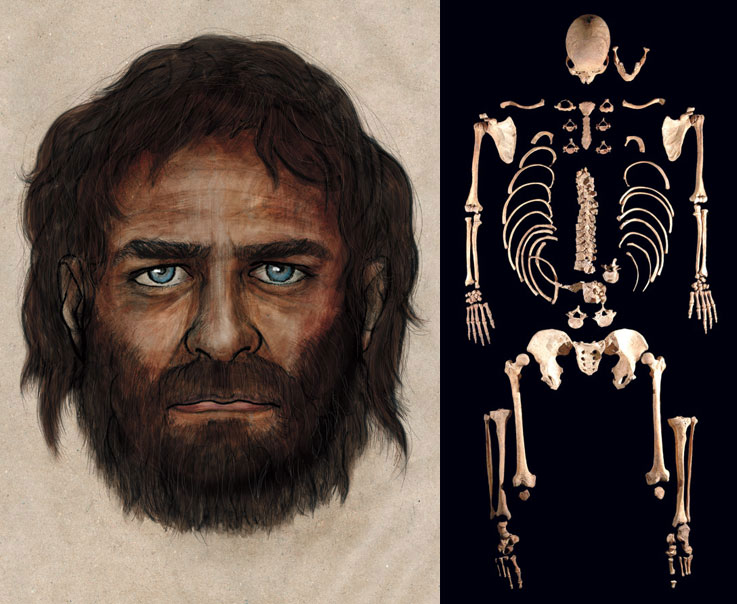
The two men had been about 30 to 40 years old when they died. They were covered in red ochre, a mineral commonly used in ancient burials. One of the men, called La Braña-1 for the archaeological site where his remains were found, was resting on a bed of broken stalagmites. The other, La Braña-2, had fallen into a neighboring pit. The only items found nearby were 24 red deer teeth that had probably been embroidered into cloth worn by La Braña-2. The skeletons’ extreme age pegged them as hunter-gatherers, but beyond that there was little to reveal who these men were and how they might be connected to the people who now inhabit northern Spain.
Little, that is, until Lalueza-Fox and his colleagues drilled into one of La Braña-1’s teeth and pulled out relatively well-preserved DNA. In January, the researchers presented the complete genome of the ancient Iberian in Nature. That genetic portrait showed startling aspects of the hunter-gatherer that researchers never could have deduced from the bones alone.
For one thing, the man’s pigment genes indicated he had blue eyes and dark skin, an unusual combination among modern-day Europeans. Immune system genes revealed that he was probably already resistant to some diseases carried by domestic animals, even though agriculture didn’t reach the Iberian Peninsula until centuries after his death (see sidebar).
Ancient DNA teased from skeletons like La Braña-1 is like a scrap of faded papyrus. Scientists can read in it details of human history and evolution that are invisible to researchers who rely on bones, pottery shards or threads of living people’s DNA.
“Groups all over the world are filling up the past with genetic data,” says Mark Thomas, an evolutionary geneticist at University College London. Scientists have examined a few pages from the genomes of hundreds of ancient people from around Europe and have fully deciphered the genetic instruction books of a handful of individuals. Genetic data from prehistoric Europeans are helping scientists write a new story of life on the continent. It’s a saga that illustrates how people interacted with each other and their rapidly changing environment. The latest chapters detail the spread of agriculture and the origin stories of many modern Europeans. (Story continues below map)
Foragers and farmers
Archaeologists and anthropologists have used tools, bones, pottery and other artifacts to piece together a story of how the species of hominids known as Homo sapiens left Africa and spread around the globe. The European portion of the tale begins more than 40,000 years ago with the arrival of these anatomically modern humans to the continent. By about 30,000 years ago, humans had supplanted Europe’s previous residents, Neandertals.
A major ice age that peaked about 25,000 years ago drove early Europeans to the southern and eastern parts of the continent. When the massive glaciers that had once crushed Scandinavia and much of the British Isles finally receded around 11,700 years ago, humans once again invaded the north.
As early Europeans were reclaiming the thawing north about 11,000 years ago, agriculture took hold in the Middle East and began spreading.
The prominent view has been that agriculture was an idea that went viral, infecting people who already lived in Europe. When European hunter-gatherers heard about this great new idea from the East, they gave up their nomadic existence to embrace the farming life and settled down to raise grain and domesticated animals. Once the nomads-turned-farmers were comfortably ensconced in villages, population sizes boomed, eventually giving rise to the modern cities and towns of Europe. In that view, the idea spread but the people who adopted it were the same ones who had always been in Europe.
“There was a widespread assumption that technology changes, but the people don’t,” says John Hawks, an anthropologist at the University of Wisconsin–Madison.
Some archaeologists told a very different version of agriculture’s spread. They suggested that migrant farmers carried their technology into Europe and jealously guarded it from hunter-gatherers. Either by violence, strength of numbers or hogging of resources, the farmers overwhelmed and pushed aside the hunter-gatherers.
Many people are uncomfortable with that version of events, Lalueza-Fox says. “It’s unfashionable, that movement of people. It looks aggressive.”
Analysis of ancient DNA suggests multiple story lines were playing out at once during agriculture’s formative years in Europe. Farmers may have guarded their intellectual property, even though they lived side by side with hunter-gatherers for thousands of years. As hunter-gatherer populations declined, some members adopted agriculture and interbred with farmers. Toss in multiple migrations and the rise and fall of various pottery cultures within Europe and the story gets complicated.
Wolfgang Haak, a molecular archaeologist at the University of Adelaide in Australia, has been poring over the ancient DNA manuscripts, concentrating on DNA found in mitochondria, cells’ power-producing organelles. Mitochondria are inherited from the mother, allowing researchers to use mitochondrial DNA signatures called haplotypes to trace maternal ancestry.
In 2005, Haak, then a graduate student at Johannes Gutenberg University Mainz in Germany, and his colleagues analyzed DNA from 24 Stone Age farmers who lived about 7,000 to 7,500 years ago in Germany, Austria and Hungary.
The researchers wanted to know if these early farmers were really the direct ancestors of present-day Europeans, as had long been suspected. Turns out they weren’t. The difference appeared in a mitochondrial haplotype known as N1a. About 0.2 percent of modern Europeans carry haplotype N1a.
“But when we dug up those farmers, it was 25 percent,” Haak says. “There was a real wow factor.” Today’s Central Europeans, according to the finding reported in Science, are not direct descendants of the people who tilled their land 7,500 years ago.
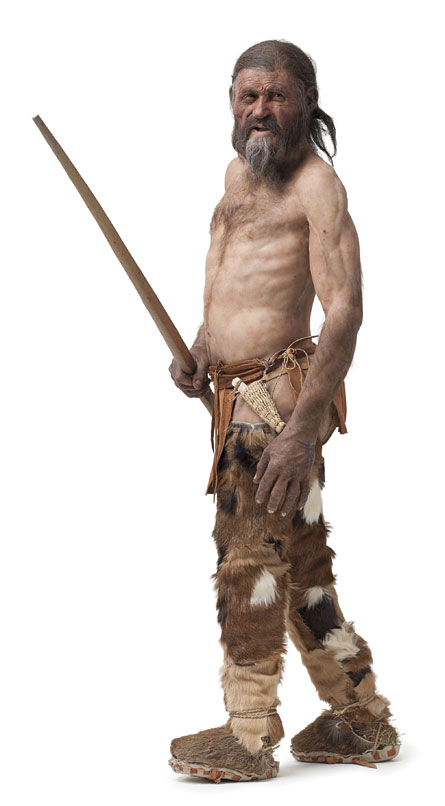
A few years after that discovery, in 2008, researchers read the mitochondrial DNA records of perhaps the most famous prehistoric European, a frozen mummy known as Ötzi, the Tyrolean Iceman. Ötzi was discovered half-buried in a melting glacier on the border between Austria and Italy in 1991. He carried a copper ax and was clad in a coat, loincloth and leggings made of domestic goatskins. His age — 5,300 years old — and implements marked him as a Copper Age farmer.
Studying Ötzi’s mitochondrial DNA, researchers discovered that he shares no maternal ancestry with modern Europeans (SN Online: 10/30/08). At first, it looked like Ötzi’s people might have died out, but a 2012 report of the Iceman’s full genetic instruction book revealed he has living relatives on his father’s side (SN: 3/24/12, p. 5). Although he was found in the ice high in the Alps between Austria and Italy, his modern relatives live more than 500 kilometers to the southwest, in Sardinia and Corsica.
The results were confusing, because modern Europeans have strong genetic ties to the region of their birth, says Lalueza-Fox. “But maybe that’s only from the Middle Ages,” he says. For several hundreds of years, people have stayed in the same place, not only the same country, but the same village, producing long, unbroken family lines. Genetic maps of modern Europe look very much like geographical maps. Less so for ancient Europeans, who were far more mobile, according to these ancient DNA studies.
Haak and his colleagues more recently collected mitochondrial DNA from hundreds of ancient skeletons from central Germany where the Saale River feeds into the Elbe. That part of Germany has been continuously inhabited for more than 10,000 years; archaeologists have uncovered remains of numerous prehistoric cultures, distinguished by their pottery styles or distinctive tools.
The team chose skeletons from the Stone Age to the Bronze Age — between 7,500 and 3,500 years old. By tracing mitochondrial haplotypes in the skeletons from different time periods, Haak’s team uncovered at least four major population shifts, which they described last October in Science (SN: 11/16/13, p. 13).
The data clearly show that early farmers were different people from the foragers who hunted wild animals and gathered plants for millennia.
Other researchers had previously examined ancient DNA extracted from hunter-gatherer skeletal remains in Germany, Spain, Sweden and other parts of Europe. The data show that the hunter-gatherers were a relatively homogenous population, at least as far as mitochondrial types go. Many of the pre-agricultural people of Europe, including the two La Braña skeletons, carried various versions of mitochondrial DNA haplotype U. They dominated Europe for more than two millennia — even after cereal grains first appeared in central Germany.
But then, in a demographic and genetic triumph, early farmers distinguished by a type of pottery decorated with lines and known as the Linearbandkeramik, or Linear Band ceramics, began to take over. Those farmers walked out of the Middle East, through what is now Turkey, and into Europe carrying a veritable alphabet soup of mitochondrial haplotypes, including N1a, HV, J, K, T2, V, W and X, Haak and colleagues reported. The hunter-gatherer lines dwindled and by 7,500 years ago, fewer than 3 percent of skeletons in central Germany bore the U haplotype.
Each time a new pottery technology appeared in central Germany, Haak and his colleagues found a new mitochondrial haplotype, suggesting that people were migrating and bringing their pottery and ideas with them. A type of bell-shaped pottery called Bell Beaker came to central Germany, for example, with ancient farmers carrying haplotype H, a genetic signature new to that region. Another farming group with haplotypes I and U2 brought Corded Ware pottery into Germany from the east about 4,800 years ago. Those groups didn’t seem to mingle with the people who were there before them.
Living side by side
A similar population separation was going on at what is now known as the Blätterhöhle archaeological site in Hagen, Germany, researchers reported last October in Science. Ruth Bollongino of the Johannes Gutenberg University in Mainz and her colleagues examined mitochondrial DNA from the teeth and bones of 25 ancient people buried in a narrow cave. To find out what the people ate, Bollongino’s group analyzed ratios of sulfur, nitrogen and carbon isotopes in the remains.
People bearing the mitochondrial signature of early hunter-gatherers were the first to bury their dead in the cave between 11,200 and 10,600 years ago, the researchers found. Those people had a diet composed primarily of wild animals.About 5,000 years later, other genetically similar hunter-gatherers used the cave, but they were freshwater fish eaters, isotope ratios revealed. At the same time that those fish-eating foragers inhabited the region, people bearing a different genetic signature, mitochondrial type H, as well as a chemical mark associated with eating domestic herbivores — such as cows and goats — were also using the cave as a burial site.
The results suggest that the hunter-gatherers and farmers led parallel lives for roughly 2,000 years, probably interacting with each other culturally. However, each group maintained its own genetic identity and diet.
That separation didn’t last forever, according to two studies — one published this April — by Mattias Jakobsson of Uppsala University in Sweden and his colleagues. The researchers examined complete genomes, not just mitochondrial DNA, of seven Stone Age hunter-gatherers and four farmers from Sweden. If the two groups had interbred, the scientists should have seen traces in this comprehensive picture of their DNA.
Remains of six seal hunters who used pottery known as Pitted Ware ceramics were excavated from burial grounds on the island of Gotland. Skeletons from those burial grounds range from about 4,400 years old to 5,300 years old. An even older hunter-gatherer, Stora Förvar11, was interred between 7,250 and 7,500 years ago in a cave on the nearby island of Stora Karlsö. The four farmers, known as Gökhem2, 4, 5 and 7, were buried less than 400 kilometers away under a large stone structure between 5,280 and 4,750 years ago. Chemical analysis showed that they had spent their lives within 100 kilometers of the structure.
The groups had probably lived side by side for at least 1,000 years, or about 40 generations. The farmers appear to have embraced the hunter-gatherers and interbred with them, Jakobsson’s group reported April 24 in Science after examining the ancient Swedes’ genomes. The Gökhem farmers had more forager ancestry than Ötzi did. The Iceman’s more meager hunter-gatherer heritage reflects the fact that his people hadn’t migrated as far as the Swedish farmers had, so probably encountered and interbred with fewer hunter-gatherers, researchers say.
But the mingling went only one way; the seal hunters, who had no farmer DNA, appear to have kept their genetic distance from their agricultural neighbors.
Today, there’s no one in Europe quite like the Swedish hunter-gatherers or La Braña-1. But, says Jakobsson, “parts of their genomes live on all across Europe.” Eventually, pure foragers died off or assimilated into farming families. Those who had interbred with the farmers passed along the hunter-gatherer genetic legacy. The amount of hunter-gatherer heritage in modern Europeans varies geographically, with people in the north claiming much more forager ancestry. People in Southern Europe have more farmer and fewer hunter-gatherer ancestors, Jakobsson’s group found.
Three ancient groups
That’s a pattern also found by a large international group of researchers, including David Reich of Harvard University and Svante Pääbo of the Max Planck Institute for Evolutionary Anthropology in Leipzig, Germany.
Just two days before Christmas, the researchers delivered a gift for those interested in prehistoric genetics to the bioRxiv.org preprint server: descriptions of the full genetic makeups of nine ancient Europeans and their links to modern people. The ancient specimens were the 7,500-year-old remains of a farmer woman from Stuttgart, Germany, an 8,000-year-old hunter-gatherer skeleton discovered in the Loschbour rock-shelter in Luxembourg and the skulls of seven hunter-gatherers that had been mounted on stakes and sunk into a lake 8,000 years ago at the Motala site in southern Sweden.
The researchers had compared those old genomes, as well as DNA from Ötzi, Gökhem4 and his hunter-gatherer contemporaries and La Braña-1, with new data collected from 2,196 living people representing 185 populations from around the world.
Modern-day Europeans, the team concludes, are a complex mix of at least three ancient groups: the early European farmers, Western European hunter-gatherers (like La Braña-1) and a third group the researchers call the ancient north Eurasians.
Eske Willerslev, an evolutionary geneticist at the University of Copenhagen, and his colleagues revealed that mysterious third group in January via the genomes of two Ice Age Siberians (SN: 12/28/13, p. 16).
One of the Siberians was a young boy buried 24,000 years ago near Lake Baikal. The child, known as Mal’ta-1, is genetically unlike any living group of people today. His genetic profile lies somewhere between that of western Eurasians and Native Americans, Willerslev and colleagues reported in Nature. That finding helps explain why some Native Americans have similar genetic signatures to Europeans; both groups got DNA from the Mal’ta child’s people.
Native Americans can trace up to a third of their genetic makeup to the ancient Siberians. Reich and his colleagues say Europeans may get up to 20 percent of their genetic heritage from those northern people.
The Siberians came later to the party than other groups. Neither the Stuttgart woman nor the Loschbour man were genetically linked to the Siberians, but the Swedish foragers whose heads were mounted on spikes did bear a slight genetic resemblance to the Mal’ta child.
One of the seal hunters from Gotland, called Ajvide58, got about 15 percent of his DNA from the Mal’ta people, Jakobsson’s team found. The Scandinavian hunter-gatherers probably passed on that Siberian ancestry to other Europeans via the farmers, but can’t have been the only group to do so.
The complete account of European prehistory and its present-day legacy is still being written. Some chapters are sure to be revised or rewritten entirely as ancient DNA adds additional dramatic details. And unexpected new plot twists also await researchers as they uncover more founding European foragers and farmers, each with his or her own genetic tale to tell about what may be the Western world’s first culture clash. (Story continues below graphic)
Skin Deep Evolution
Ancient DNA is more than a tool to trace ancestry; it’s a window on human evolution
One major assumption about human evolution in Europe was challenged when researchers examined pigment genes from two ancient hunter-gatherers. The 7,500 year-old La Braña-1 man from Spain and the 8,000 year-old Loschbour man from Luxembourg both had blue eyes combined with the dark skin reminiscent of their African ancestors.
Many researchers had thought that Europeans quickly developed light skin upon settling the continent before the Ice Age. They reasoned that low levels of sunlight in northern latitudes would make it hard for dark-skinned people to generate enough vitamin D to keep their bones strong. Therefore, natural selection should favor lighter-skinned people, who made less of the light-blocking pigment melanin, letting in more vitamin-D building ultraviolet rays.
It is a compelling theory, but was nearly impossible to test using genetic data from living people to infer what happened long ago. So Mark Thomas of University College London and his colleagues decided to eliminate the guess work and measure natural selection directly from ancient DNA.
Thomas and his colleagues probed pigment genes in the skeletons of 40 Copper and Bronze Age people from the Pontic-Caspian steppe, mostly from Ukraine. Those skeletons ranged in age from about 6,500 years old to about 4,000 years old.
The researchers examined three pigment genes (SLC45A2 and TYR for skin color and HERC2 for eye color) in the ancient people and in 60 present-day Ukrainians. In each case, the gene variants associated with lighter skin and blue eyes increased in the last 5,000 years, and did so at a rate that probably couldn’t be achieved by chance. In other words, natural selection was driving skin tones toward ever-lighter hues, Thomas and his colleagues reported March 10 in the Proceedings of the National Academy of Sciences. The team calculated that the lighter pigment versions of each gene gave about a 2 percent to 10 percent selective advantage in each generation, indicating that something in the environment was driving the change.
The data, unfortunately, are mute on the reason natural selection favored lighter skin color. “We can tell you selection has operated on a particular variant, but we can’t say why,” Thomas says.
The earliest Europeans, like the La Braña and Loschbour hunter-gatherers, probably could afford to have darker skin in sun-starved Europe because they ate meat and fish that could supply their vitamin D, Carles Lalueza-Fox speculates. It could be that farming changed the diet enough, with a shift toward grains, to make synthesizing vitamin D in the skin a priority, he says.
Skin color at least has the plausible vitamin D hypothesis going for it. The evolutionary advantage of blue eyes, however, is harder to explain. Vitamin D probably has nothing to do with light eye color, Thomas says. The next option, he says, is that perhaps blue-eyed people were considered more attractive and won more mates than the brown-eyed. Or maybe group selection was at work, so that people with blue eyes tended to mate with other blue-eyed people, increasing their numbers. “I’m waving my arms around here. I don’t know,” Thomas admits. — Tina Hesman Saey
